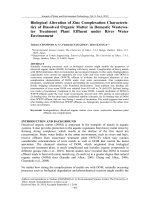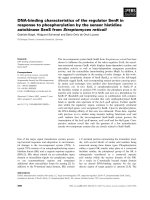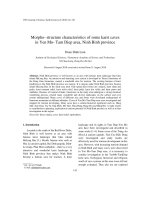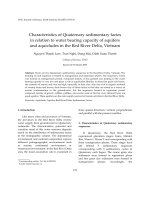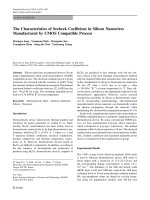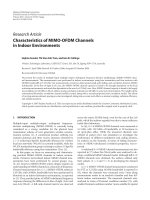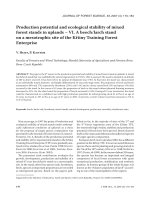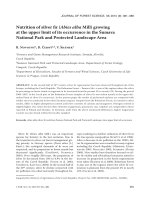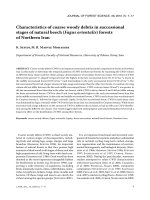Characteristics of mangrove forest communities in xuan thuy national park nam dinh
Bạn đang xem bản rút gọn của tài liệu. Xem và tải ngay bản đầy đủ của tài liệu tại đây (9.3 MB, 67 trang )
MINISTRY OF AGRICULTURE AND RURAL DEVELOPMENT
VIETNAM FORESTRY UNIVERSITY
STUDENT THESIS
Title
CHARACTERISTICS OF MANGROVE FOREST COMMUNITIES
IN XUAN THUY NATIONAL PARK – NAM DINH
Major: Natural Resources Management
Code: D850101
Faculty: Forest Resources and Environmental Management
Student: Vu DucHuy
Student ID: 1253090017
Class: K57 Natural Resources Management
Course: 2012 - 2016
Advanced Education Program
Developed in collaboration with Colorado State University, USA
Supervisor: Dr.HaQuang Anh
Ha Noi, 10/2016
ACKNOWLEDGEMENTS
During the process of learning and finishing this thesis, I have received guidance,
valuable help of the teachers and friends. Without their assistances, advice, collaborations
and supports, this thesis would not have been possible.
First and foremost, I would like to thank all teachers in Advanced Program for the
valuable knowledge and your enthusiasm to build strong background, especially my
supervisor - Dr. Anh Quang Ha. I am grateful to him for valuable guidance, supporting and
comments throughout the various stages of this thesis, what help me carry out this thesis.
Many thanks are due to my friends in K57 – Advanced Curriculum. You help me a
lot when I collect and analyze data. Thanks for study time we have been together at
Vietnam National Forestry University. I always appreciate our friendship.
Lastly, I express my gratitude to management board of Xuan Thuy National Park.
Thanks Mr. Nguyen Viet Cach – Head of XTNP and Mr. Pham Xuan Hoi for your help
when I was in XTNP, and Mr. Ngo Xuan Chieu for your directly guidance to help me
collect valuable data.
Hanoi, October 2016
Vu Duc Huy
ABSTRACT
Mangrove ecosystems play significant role for protecting coastal areas. However,
the area and quality of mangrove are affected not only by weather patterns, but by human
activities also. Understanding the structure of mangrove community and regeneration are
very important to manage mangrove ecosystem effectively. Field investigation and statistic
are main method that use in this research. Mangrove community in Xuan Thuy National
Park (XTNP) include three main woody species Kandelia candel, Sonneratia caseolaris,
and Aegiceras corniculata that make up five types of forests. Mangrove forests in XTNP
grow and develop well, high density, and in high quality. However, regeneration trees are
in low quality. They distribute unequally, randomly and in low density. Regeneration trees
are mainly damaged by weather condition (storm, sea-level rising) and human activities
(collecting NTFPs, waste water from aquaculture area). In order to enhance quality of
mangrove forests and regeneration in XTNP, some silviculture technique should be applied
such as: plant new species that adapt to the environment conditions in study area
(Sonneratia apetala), selective thinning to reduce competition between individual trees,
control waste water from aquaculture area before release to the environment, raise
awareness for people to protect mangrove forests and limit activities which damage to the
forests, especially in core zone.
Key word: mangrove; regeneration; structure.
1
TABLE OF CONTENT
ACKNOWLEDGEMENTS
ABSTRACT ..................................................................................................................... 1
TABLE OF CONTENT .................................................................................................. 2
LIST OF TABLE ............................................................................................................. 2
LIST OF FIGURE ........................................................................................................... 4
ABBREVIATION............................................................................................................ 5
1. INTRODUCTION: ...................................................................................................... 6
2. GOALS AND (SPECIFIC) OBJECTIVES: ............................................................. 12
2.1. Overall goal: ......................................................................................................... 12
2.2. Specific objectives: ............................................................................................... 12
3. METHODS: ............................................................................................................... 12
3.1. Secondary data ...................................................................................................... 12
3.2. Sample plot establishment ..................................................................................... 13
3.3. Data collection ...................................................................................................... 14
3.4. Data analysis ......................................................................................................... 16
4. OVERVIEW OF STUDY SITE ................................................................................ 18
4.1. Natural characteristic ............................................................................................ 18
4.1.1. Geographical location ..................................................................................... 18
4.1.2. Topography and hydrology ............................................................................. 19
4.1.3. Climate ........................................................................................................... 20
4.1.4. Soil condition ................................................................................................. 20
4.1.5. Biodiversity .................................................................................................... 21
4.2. Population ............................................................................................................. 22
4.3. Economic condition .............................................................................................. 22
5. RESULTS .................................................................................................................. 23
5.1. Structure of mangrove forests ................................................................................ 23
5.2. Structure of regeneration ....................................................................................... 45
6. DISCUSSION ............................................................................................................ 55
7. CONCLUSION .......................................................................................................... 58
REFERENCES:............................................................................................................... 0
APPENDIX:..................................................................................................................... 1
2
LIST OF TABLE
Table 5.1: Table of statistic of forest status 1 ................................................................... 23
Table 5.2: Table of height distribution frequency in plot 1 of forest status 1 .................... 24
Table 5.3: Table of height distribution frequency in plot 2 of forest status 1 .................... 24
Table 5.4: Table of height distribution frequency in plot 3 of forest status 1 .................... 25
Table 5.5: Table of statistic of forest status 2 ................................................................... 27
Table 5.6: Table of height distribution frequency in plot 1 of forest status 2 .................... 28
Table 5.7: Table of height distribution frequency in plot 2 of forest status 2 .................... 28
Table 5.8: Table of height distribution frequency in plot 3 of forest status 2 .................... 29
Table 5.9: Table of statistic of forest status 3 ................................................................... 31
Table 5.10: Table of height distribution frequency in plot 1 of forest status 3 .................. 32
Table 5.11: Table of height distribution frequency in plot 2 of forest status 3 .................. 32
Table 5.12: Table of height distribution frequency in plot 3 of forest status 3 .................. 33
Table 5.13: Table of statistic of forest status 4 ................................................................. 35
Table 5.14: Table of species composition in forest status 4 .............................................. 36
Table 5.15: Table of height distribution frequency in plot 1 of forest status 4 .................. 37
Table 5.16: Table of height distribution frequency in plot 2 of forest status 4 .................. 37
Table 5.17: Table of height distribution frequency in plot 3 of forest status 4 .................. 38
Table 5.18: Table of statistic of forest status 5 ................................................................. 39
Table 5.19: Table of species composition in forest status 5 .............................................. 40
Table 5.20: Table of height distribution frequency in plot 1 of forest status 5 .................. 41
Table 5.21: Table of height distribution frequency in plot 2 of forest status 5 .................. 41
Table 5.22: Table of height distribution frequency in plot 3 of forest status 5 .................. 42
Table 5.23: Table of regeneration investigation in forest status 1 ..................................... 45
Table 5.24: Table of regeneration investigation in forest status 2 ..................................... 47
Table 5.25: Table of regeneration investigation in forest status 3 ..................................... 49
Table 5.26: Table of regeneration investigation in forest status 4 ..................................... 51
Table 5.27: Table of regeneration investigation in forest status 5 ..................................... 53
3
LIST OF FIGURE
Figure 3. 1: Measurement equipment ............................................................................... 14
Figure 4. 1: Xuan Thuy National Park (Source: Xuan Thuy National Park, 2015) ............ 18
Figure 5.1: H-D correlation in forest status 1 ................................................................... 26
Figure 5.2: H-D correlation in forest status 2 ................................................................... 30
Figure 5.3: H-D correlation in forest status 3 ................................................................... 34
Figure 5.4: H-D correlation of Kandelia candel in forest status 5 ..................................... 43
Figure 5.5: Quality of regeneration in forest status 1 ........................................................ 46
Figure 5.6: Quality of regeneration in forest status 2 ........................................................ 48
Figure 5.7: Quality of regeneration in forest status 3 ........................................................ 50
Figure 5.8: Quality of regeneration in forest status 4 ........................................................ 52
Figure 5.9: Quality of regeneration in forest status 5 ........................................................ 54
4
ABBREVIATION
XTNP:
Xuan Thuy National Park
NTFPs:
Non-timber forest products
UNESCO:
the United Nations Educational, Scientific and Cultural Organization
DBH:
Diameter at Breast Height
Dcanopy:
Diameter of canopy
5
1. INTRODUCTION:
Mangroves are found in 123 countries and territories globally; with total area is
152,000 square kilometers (Spalding et al., 2010). The term “mangrove” considers both
ecosystem and the plant families that have adaptability to grow in tidal environment
(Tomlinson, 1986). Mangrove tree grow between latitudes 25oN and 30oS (Valiela et al.,
2001). They form forests of salt-tolerant species, with complex food webs and ecosystem
dynamics (Macnae, 1968; Lugo and Snedaker, 1974; Tomlinson, 1986). The first attempt
to estimate total mangroves area over the world was undertaken as part of “Tropical Forest
Resources Assessment” (FAO and UNEP, 1980). The total mangrove area was estimated
approximately 15.6 million hectares in this study. Dynamic of mangroves area over years
was estimated continuously over year through many report such as Saenger et al.,(1983),
FAO (1994), Groombridge (1992), ITTO & ISME (1993), Fisher & Spalding (1993),
Spalding et al.,(1997), Alzupuru et al.,(2000). In Vietnam, mangrove vegetation is divided
into 4 zones: North-east coast from Ngoc cape to Do Son cape (zone I), Northern delta
from Do Son cape to Lach Truong River (zone II), central coast from Lach Truong to
Vung Tau cape (zone III) and Southern delta from Vung Tau cape to Ha Tien (zone IV).
Only number of plant species has physiological and structural characteristics in
order to adapt to the brackish water habitat, for example: Rhizophoraceae, Avicenniaceae
and Combretaceae - the number of species is ranges from 50 to 70 according to different
classification (Tomlinson, 1986; Saenger, Hegerl and David, 1983; Lugo and Snedaker,
1975; Aksornkoae et al., 1992). Processing exceed salt in the absorbed water is one of the
biggest challenges in the salty environment. Mangrove tree species have several methods
to desalinate ocean water, according to species (FAO, 2007). They may exclude the
uptake of salt at the root level, or remove excess salt at the leaf level by using salt
6
excretion glands, by cuticular transpiration at the leaf level transpiration at leave level, or
by accumulating the salt in leaf tissues and then shedding the leave (FAO, 2007).
Mangrove ecosystems provide not only ecological functions, but economic
functions also. There are number of ecological functions which are provided by mangrove
ecosystems such as:
- Reduction of environment pollution. It helps to consume a significant amount of
harmful emission and increase the amount of oxygen release to the environment. Thus, it
can contribute to reduce the global warming and prevent rising of water affect the lives of
coastal resident.
- They play significant role as filters in the processing of waste. In addition, it also
works to handle nutrients from land and served as buffers against pollution runoff and filter
food for marine animals.
- Help protect animals when high tide and big waves, making the diversity of
mangrove ecosystems are relatively stable.
- Through the dense root system of mangrove, they can protect estuarine coastal from
erosion and prevent and reduce consequences of storms and waves on the sea dyke system.
- A good place to organize eco-tourism, training, research and teaching.
Moreover, mangroves ecosystems play an important role in providing economic
benefit at local and national level. Local people depend on mangrove as the source of
wood (timber, poles, fuel-wood and charcoal) and NTFPs (food, thatch, alcohol, medicine
and honey). Mangroves also provide tannin, suitable source for leather work and for
curing and dyeing of fishing nests. However, this product has declined in recent years,
mainly because of the introduction of nylon fishing nets and the use of chrome as the
predominant agent for curing leather (FAO, 1994).
7
The first research on mangrove ecosystem in Vietnam is doctoral thesis of
Humbert-Vu Van Cuong (1964). He described in detail saltwater communities and
brackish communities in Sai Gon River and Vung Tau with soil factors. The second
research is a book named “Mangrove forest in Vietnam” of Nguyen Van Than and Lam
Binh Hoi (1972). In this book, they identified and analyzed based on silviculture
technique. Thesis of Phan Nguyen Hong (1970) on “Ecological characteristic of flora,
vegetation floor in coastal area of Northern Vietnam” and his number of reports also
mentioned quite enough characteristics if mangrove forests in northern Vietnam.
In Vietnam, there is a special committee research on mangroves that names MERD
(Mangrove Ecosystems Research Division) belong to CRES (Centre for Natural
Resources and Environment Studies). Besides, there are other Center of Natural Resources
and Environment of Forest Inventory and Planning Institute, Institute of Forestry, Vietnam
National University of Forestry to participate in research on mangroves ecosystems.
Xuan Thuy National Park locates in Giao Thuy district, Nam Dinh Province. The
area was declared the country’s first Ramsar site by the Bureau of the Convention on
Wetlands of International Importance 3 in January 1989. Since then, the Government of
Vietnam has worked very hard to preserve the value of this area through the establishment
of new laws, policies and investments. In 2003, it was upgraded from its status as a nature
reserve and approved as a national park by the Prime Minister, and was also included as
part of the Red River Delta World Biosphere Heritage Site by UNESCO in October 2004.
The total area is approximately 7,100 hectares of core zone, and 8,000 hectares of buffer
zone. While core zone is a strictly protected area without any human activities allowed,
the buffer zone acts as transition area where activities are regulated to restrict and reduce
adverse human impacts on the park. Endowed with rich alluviums, the park boasts a
8
unique wetland habitat with diversified species of flora and fauna, especially migratory
birds. XTNP is the home for a total of 219 bird species belonging to 41 families and 13
orders, in which nine have been recorded as endangered species in the Red Data Book.
The aquatic biodiversity of this wetland ecosystem provides food and wetlands-dependent
livelihoods for the locals in the five communes in the buffer zone include Giao Thien,
Giao An, Giao Lac, Giao Xuan and Giao Hai, and other communes in the neighboring
areas. Thousands of people from different backgrounds, regardless of gender, age,
religion, and wealth, have been utilizing the wetlands daily for many years for aquaculture
activities, especially shrimp and clam farming, and various aquatic harvesting activities.
Along with the fast growing population, there is an increasing pressure on these natural
resources – being exploited for food, livelihood activities and other demands of not only
over 45 thousand of local people but of people coming from other areas because products
from the wetlands are being used locally, as well as being marketed to big cities and
abroad. Besides human activities, natural changes caused by sedimentation, water flow,
climate change and sea level rise, are contributory factors adding more pressure and
concern for XTNP Management Board in terms of fulfilling their mandates as a national
park and a Ramsar site. Many mangrove forests cover mature aquaculture farms, but there
are also many large areas of mudflat have been planted with monoculture page. In 1996,
there is 300 hectares of Phragmites in the lagoon area of Con Ngan (Pedersen and Nguyen
Huy Thang, 1996). However, until 2000 the reed beds disappeared (J. Eames, 2000).
Consequently, Xuan Thuy has faced with various environmental and social issues that are
threatening in the sustainability of resources and habitat for waterfowl. Three major issues
in Xuan Thuy national park were identified in the strategic plan (2008), including (I)
Negative changes and degradation of natural resources, (II) Unsustainable livelihood
practices of local communities, and (III) Limited capacity of concerned institutions in
9
wetlands management. Though many problems are the result of external factors that the
local have no or low control over, like global climate change, pollutants from upstream of
Red River and National Laws, among others, local partners of the Xuan Thuy national
park Network has acknowledged the fundamental issues that link directly to limited
awareness and capacity of local authorities and communities.
Protecting and regenerating mangroves in coastal regions have becoming an
extremely important task of the Government, local authorities, organizations and
individuals. The coastal mangroves extents in Xuan Thuy district, Nam Dinh province is
not out of this trend. Mangroves are one of the most important resources of Nam Dinh
province, and in the development process, as well as one of the forest resources are
threatened the most havoc. In recent years, efforts to protect forests in the province of
Nam Dinh has many remarkable results, the Xuan Thuy commune had set up a specialized
forest protection task force with 4 members and some equipment. Realizing the impact of
tides and storms, Nam Dinh province has launched hundreds of mangroves plantation
campaign to counter typhoons and climate change, and has planted tens of thousands of
hectares of trees. To promote afforestation, coastal communities have sought to allocate
forest land to household management and afforestation. Accordingly, the growers will
enjoy the planting and care funding from the district and commune, and they would enjoy
all the marine resources brought from the forest, so people are actively involved in this
project. Forest development efforts have brought significant changes in the scale and
quality of forests in Xuan Thuy.
The restoration of mangroves in the destroyed area is the urgent and necessary.
One of the critical success factors is the understanding of the structure and regrowth as a
basic to build the appropriate planting method. Furthermore, research on structural
10
characteristics such as composition, density, height, DBH and coverage cover can be the
basis to carry out other study about role and protected function of mangrove. From this
idea, I carry out the research “CHARACTERISTICS OF MANGROVE FOREST
COMMUNITIES IN XUAN THUY NATIONAL PARK – NAM DINH”
11
2. GOALS AND (SPECIFIC) OBJECTIVES:
2.1. Overall goal:
Thesis identifies several basis structural characteristics of mangrove flora
communities in study area. From that propose number of silviculture technique to manage
and develop mangrove area in XTNP.
2.2. Specific objectives:
- Identify structuralcharacteristic of different flora communities in Xuan Thuy
National Park: name of species, composition, density, DBH, height, canopy diameter and
quality of community.
- Identify regeneration structure of mangrove in XTNP: number of sapling and
seedling, quality of sapling and seedling.
- Provide some silviculture technique to protect, manage and develop mangroves
in study area.
3. METHODS:
3.1. Secondary data
Collect data bases on exist document and related report: data about natural, socioeconomic condition of study area; data from previous studies in the study area. Most of
data come from Statistic of XTNP, or Statistic of Giao Thuy district.
12
3.2. Sample plot establishment
After primary investigation, there are five different communities have been identified. In
this study, 3 plots are established for each status of mangrove forest
-
Status 1: only Kandelia candel(K)
-
Status 2: only Sonneratia caseolaris(S)
-
Status 3: only Aegiceras corniculata(A)
-
Status 4: mix between Kandelia candel and Aegiceras corniculata(K+A)
-
Status 5: mix between all three species (K+S+A)
Three sample plots are established inside of the community to investigate structure
base on simple random sampling method. Each sample plot has area of 100m² (10m x
10m). In each plot, number of structural characteristics are recorded for example
composition, number of each species, height, DBH, canopy diameter and canopy coverage.
1
0
10m
13
To investigate regeneration, 5 sub-plots are established inside of plot. 4 sub-plots
are in 4 corner of plot and 1 in the middle. Each sub-plot is 4m² (2m x 2m). In sub-plot,
number of characteristics of sapling is investigated such as number of sapling, species,
composition, quality and growth ability.
2m
10m
10m
2m
3.3. Data collection
After establish plots, some basic data are collected from plot, including: name of
species, height, DBH, canopy diameter, health situation to determine the quality and
situation of mangroves forest. The data is record in sample table 1.
Figure 3. 1:Measurement equipment
14
Sample 1: Data collection survey
Location:
Date of survey:
ID
Species
Investigator:
Height
DBH
Dcanopy
Note
Height: in meter. Height is measured by using a long pole with graduation of 10cm.
DBH: in centimeter. DBH is measured by using Caliper, or measure tape then
divide by 3.14.
Dcanopy: in meter. Dcanopyis measured by using a long pole with graduation of 10cm
or a linear tape.Dcanopy is measured twice with two perpendicular directions. Then take the
average from two measurements.
To investigate canopy cover, use 100-step method. Walking 100 steps. At each
step, looking skyward through small tube and check if you see, see a half, or not see
canopy. Three levels have been recorded:
Canopy do not cover when see skyward through the tube
0
Canopy covers a part of sight through the tube
0.5
Canopy covers all the sight through the tube
1
To investigate regeneration, trees which are lower than 1.5m in each sub-plot are
counted and assessed the quality. They are assessed on three level:
15
Good
Grow well, straight stem, canopy grow equally, no topless, no pests,
Bad
Not straight, topless, have pests
Medium
Between two types above
3.4. Data analysis
After collecting, data will be statistic by using Excel and number of formula:
- Identify composition coefficient of species in plot by following formula:
N: total number of trees in plot
- Identify density:
D: density per hectare
n: number of trees in plot
S: area of plot, in this case equal10*10 = 100m²
- Using Descriptive statistic to analyze information about height, DBH, and D canopy. Using
Regression to identify relationship between height and DBH. Using Histogram to identify
frequency distribution bases on Height and DBH.
16
- Calculate canopy cover by summing up 100 measurements.
- Assess distribution and quality of regeneration: calculate density of regeneration
In case of regeneration:
D: density of regeneration per hectare
n: total number of trees which are lower than 1.3m in sub-plot
S: total area of sub-plot, in this case equal 4(m²/sub-plot)*5(sub-plot/plot) = 20m²/plot
- Identify quality of regeneration:
X%: percentage of good, bad, or medium trees (base on n)
n: number of regeneration trees which are good, or bad, or medium in sub-plot
N: total number of regeneration trees in all sub-lot
- Identify composition coefficient of species in plot by following formula:
N: total number of trees in plot
17
4. OVERVIEW OF STUDY SITE
4.1. Natural characteristic
4.1.1. Geographical location
Figure 4. 1:Xuan Thuy National Park(Source: Xuan Thuy National Park, 2015)
Xuan Thuy National Park is located in Giao Thuy District, Nam Dinh Province,
150 kilometer south-east from Hanoi. This is the largest coastal ecosystem in the north of
Vietnam. It lies between North 20o10’ – 20o15’, and East 106o20’ – 106o32’. It touches the
18
Red River in the North. In the West, it touches 5 communes of Giao Thuy District:
GiaoThien, GiaoAn, Giao Lac, Giao Xuan, and Giao Hai. In the East and Southeast, it
touches South China Sea
This national park includes two parts: the Core Zone and the Buffer Zone. The
Core Zone has total area of 7,100 hectares; include 4,000 hectares of low tide wetlands and
3,100 hectares of land. It covers the islets of Con Ngan, Con Lu and Con Xanh. The largest
islet – Con Ngan – is covered by aquaculture farms and some part of mangroves. Con Lu
islet is covered by sandy areas such as alluvial flats and number of aquaculture farms. Con
Xanh is the smallest islet, is being widened by alluvium from Red River and covered by
layer of sand.
The Buffer Zone has total area of 8000 hectares. The area includes land enclosed
by sea dikes with fringing marshes. The area has a long history of wet rice cultivation as
well as dike construction and land reclamation (Statistic of Giao Thuy District’s
government, 2013)
4.1.2. Topography and hydrology
XTNP is located in the coastal area of the Red River basin, at Ba Lat Estuary.
Reserve includes dunes and interspersed among them are the mud flats. Con Ngan is the
largest sand dunes, on which primarily aquaculture ponds and mostly covered with
mangroves. Con Lu includes a vast sandy beaches, mudflats and marshes and a small area
of aquaculture ponds. Con Xanh is the smallest dune with thin layer of sand and continue
to cultivate by silt from the Red River offers. Con Xanh and Con Lu are often flooded in
high tide. The southern boundary of the park is the Vop river mouth. In protected areas, the
highest point is 3m and the deepest is 6m in comparison with sea level. Salinity is high and
19
different between seasons. In summer, salinity is lower, from 20‰ to 27‰. The salinity in
winter is relatively higher, from 28‰ to 30‰.
4.1.3. Climate
XTNP lies in the tropical monsoon region, which has two distinct seasons. A hot
and rainy season is from April to October and a cold and dry season from November to
next March. The annual average temperature is 24oC. The highest temperature can reach
40.3oC and the lowest temperature is 6.8oC. Temperature range is high.
The annual rainfall is between 1700 and 1800mm. There are averagely 133 rainy
days per year, mainly in summer (from May to October). Because of high amount of
rainfall, the park has high humidity, average is 84%. In winter, humidity is lower, mainly
lower than 75%. Humidity in summer is significant high, from 80% to 90%. Average
evaporation is approximately 100mm per month.
Because of tropical monsoon region, there are two distinct wind each year. Wind
flow Northeast direction in winter, and Southeast direction in summer. The average speed
is 4 – 6m/s. However, speed can reach 40 – 50m/s when storms come (mainly in summer).
July and August seem to be the stormiest months, where the storms are followed by
heavy rain. Three strong storm have been recorded in 2015: in 28 July with level 7, 18
September with level 9, and 28 September with level 12.
4.1.4. Soil condition
Soil in this area is made up of silt of the Red River and South China Sea. There are
two main types of soil formed from the alluvium of the Red River. One is alluvial mud,
which becomes loam, and other is sand. Transported by water the alluvial forms the coastal
20
soil like light soil such as sand, light loam and pure sand; medium soil and heavy soil such
as loam and clay.
4.1.5. Biodiversity
XTNP has 14 types of habitats, including the natural habitats and artificial habitats
(Pedersen and Nguyen Huy Thang, 1996). Habitat valuable highest biodiversity is the
mudflats and mangroves naturally less affected. There are 115 species of vascular plants
were recorded in the study area, including the main mangrove species and the species
involved in the mangrove forests, species from inland migration to and adapt to the
conditions at Xuan Thuy National Park of 101 genera. Among them, the fernPolypodiophyta has 7 species of 7 genera, 5 families; two cotyledons-Dicotyledones class
has 80 species, belonging 70 genera; a cotyledon - Monocotyledons class has 28 species
belonging to 24 genera, 6 families. There are 7 species of plants directly involved in the
mangrove forest named: Aegiceras corniculata, Sonneratia caseolaris, Kandelia obovate,
Rhizophorastylosa, Acanthus illcifolius, Acanthus ilicifolius, and Derris trifoliate.
The park regularly records 8 species of bird are threatened and near threatened at
global scale, include: Platalea minor (Spoonbill), Egrettaeulophotes(Chinese egret),
Tringatotanus (common Redshank), Larussaundersi (Gull), Pelecanusphilippensis (spotbilled pelican), Calidrispygmeus (spoon-billed sandpiper), Mycterialeucocephala (painted
stork), and Limnodromussemipalmatus (Asian dowitcher). Moreover, XTNP is the
important stopover for many migratory birds in winter such as Tringaerythropus. Due to
the international importance of the bird conservation, XTNP has been recognized as one of
the most important bird areas in Vietnam (Tordoff, 2002).
21
4.2. Population
According to statistic of Nam Dinh province in 2014, total population in Giao Thuy
District was 51,109 people, 13,740 households. Population density is approximately 6,546
people/km². Number of people who lives on farms accounted for 2,175 people, and lives
on fisher accounted for 676 people. Number of people in working age accounted for
25,771 people.
4.3. Economic condition
In recent years, economy in Giao Thuy District is on development, maintain high
growth rate. In five years (2006 – 2010), the value of total product per capita rose
10.71%/year. The economic structure is a positive shift towards increasing the value and
income, reducing the share of agricultural sector – forestry – fisheries; the proportion of
industry – construction sector accounted for 14%, services sector accounted for 38%, and
agriculture – forestry – fisheries accounted for 48%. Income per capita in 2010 reached
11.2 million/person/year. According to the statistic of Nam Dinh Province:
-
Agriculture – forestry – fisheries sector: gradually developed towards production of
goods and increase the value of 1 unit of arable land. Total food production reaches
101,166 tons per year, value of cultivated production reaches 66.7 million per hectare. The
production value in this sector increased averagely 3.5% per year. Structure of of
agriculture – forestry – fisheries has shifted toward increasing the proportion of animal
husbandary and fisheries. The fisheries had an average growth rate of 15.15%/year.
-
Manufacturing industry – handicraft industry: manufacturing industry and small
industry has grown quite with average growth rate of 18.91%.
22
-
In 2010, the district had 8 base salt with total area of 482 hectares, supply for
market 42,000 tons. Salt is use for domestic demand and export to Laos.
-
The service sector: total retail sales of goods in 2010 reached 493.6 billion. The
value from transportation, communications, finance activities, tourism reached 414.2
billion, with an average growth rate of 12.8%/year.
5. RESULTS
5.1. Structure of mangrove forests
a) Investigation in forest status 1:
Statistic of forest status 1 from 3 plots is shown in the table below:
Table 5.1:Table of statistic of forest status 1
Plot 1
Height
DBH
Plot 2
Dcanopy
Height
DBH
Plot 3
Dcanopy
Height
DBH
Count
46 trees
42 trees
51 trees
Density
4600 trees/ha
4200 trees/ha
5100 trees/ha
Mean
3.3
Dcanopy
4.9
1.6
3.0
3.6
1.6
2.9
4.5
1.3
Std.Dev 0.586
0.936
0.425
0.665
0.758
0.3745
0.421
0.659
0.360
Min
1.9
3.0
0.8
1.8
1.8
0.6
2.1
3.2
0.6
Max
4
6.5
2.3
4.1
5.3
2.2
3.5
6.0
2.0
23

